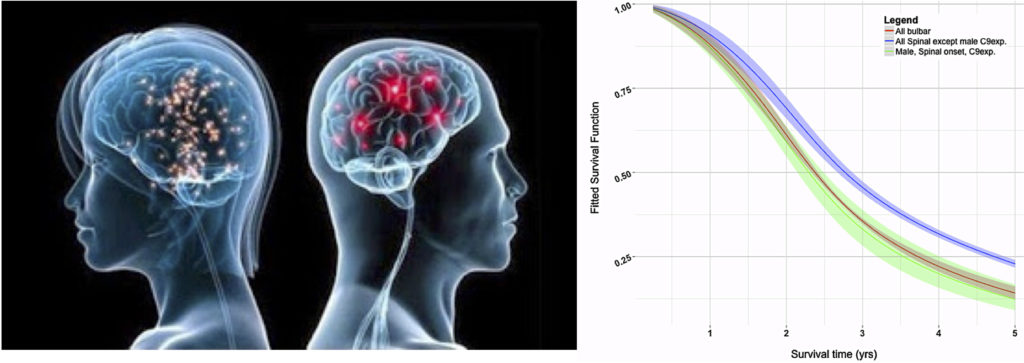The C9orf72 hexanucleotide repeat expansion has been defined as the main genetic factor in amyotrophic lateral sclerosis (ALS), particularly across the ALS-frontotemporal dementia (FTD) continuum. Clinically, the C9orf72-related ALS cases have several distinct features including an earlier age of onset, reduced survival, higher prevalence of bulbar onset and dementia, contributing to the broad clinical variability in this group of patients.
In the current issue of JNNP, Rooney and colleagues contribute to the understanding of the prognostic factors associated with the C9orf72 mutation. The authors investigated the prognostic impact of C9orf72 in European ALS patients and its interactions with demographic features such as age, gender, and site of onset. In summary, C9orf72 status and demographic/clinical data from 4925 ALS patients were analyzed using flexible parametric survival models that included the already known prognostic factors (age, diagnostic delay, and site of onset), gender and C9orf72 status. The meta-analysis of C9orf72 status estimated a survival hazard ratio (HR) of 1.36 (1.18 – 1.57). Models analysis demonstrated that males with spinal onset diseases were driving the reduced survival seen in patients with this mutation.

This study is the largest combined analysis of the prognostic features of C9orf72 ALS. Regarding gender effect on survival, it is well known that the incidence and prevalence of ALS is higher in males (male: female ratio 3:2), with a greater likelihood of earlier disease onset and spinal onset. Moreover, it has been reported that male transgenic SOD1 mice have reduced survival in comparison with female littermates, suggesting differential motor neurone vulnerability determined by gender. Even though the exact mechanics of this difference is not well understood, a recent study suggests that mitochondrial dysfunction is expressed earlier in male compared to female mice, probably attributable to oestrogen levels. Without any doubt, the definition of prognostic factors associated with the C9orf72 mutation is not trivial given the advances in molecular biology and genetics, as well as their impact on the development of future targeted therapeutic strategies. This information is highly relevant for the design of future clinical trials, particularly in the C9orf72 ALS population.
Read more at http://jnnp.bmj.com/content/jnnp/88/4/281.1.full